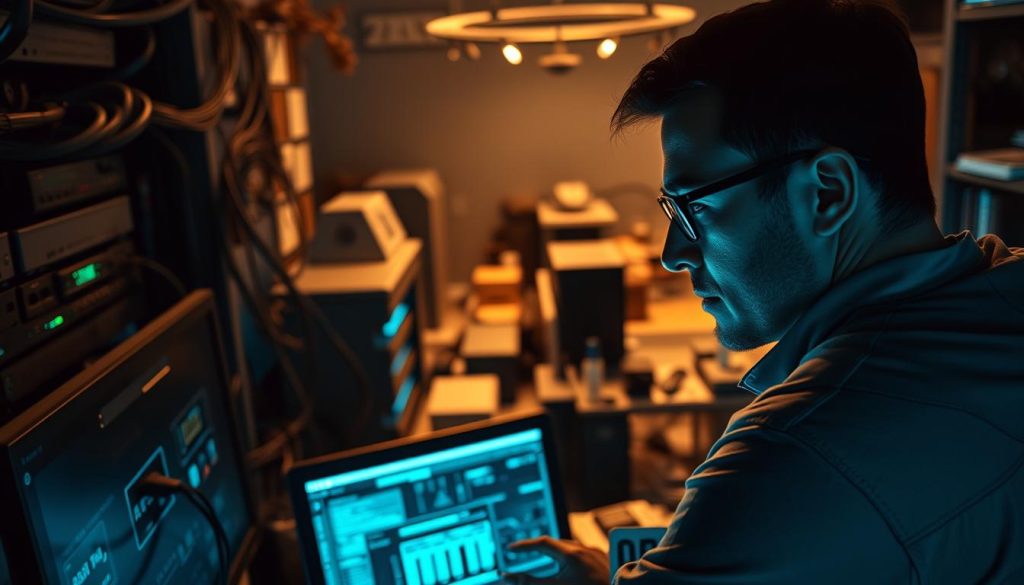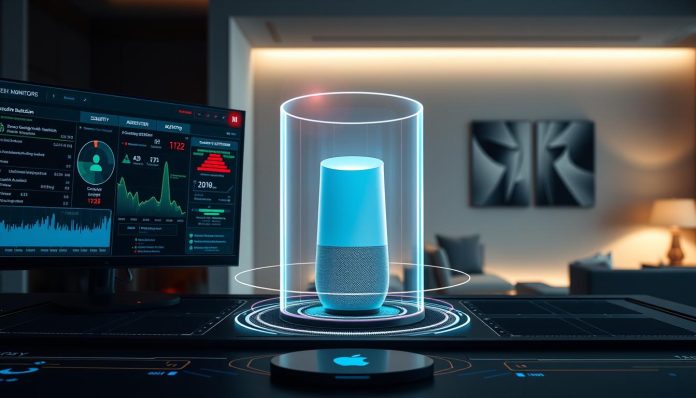You use voice assistants like Alexa, Google Assistant, and Siri to make your life easier. But, using them can also put your personal data at risk. When you talk to them, you share information that could be accessed without your permission.
Securing your voice assistant is key to keeping your data safe and private. It’s important to know the risks and how to protect yourself.
By securing your voice assistant, you can enjoy their benefits while reducing risks. In this article, we’ll show you why securing voice assistants is important. We’ll also give you tips to improve your security.
Key Takeaways
- Understand the potential risks associated with using voice assistants.
- Learn best practices to secure your Alexa, Google Assistant, or Siri.
- Discover how to protect your personal data when using voice assistants.
- Implement measures to minimize unauthorized access to your voice assistant.
- Enhance your overall security and privacy with voice assistants.
Understanding Voice Assistant Security Risks
Voice assistants are now a big part of our daily lives. But, they also come with security risks we need to know about. It’s key to understand the vulnerabilities and privacy concerns they bring.
Common Vulnerabilities in Voice Assistants
Voice assistants, like other connected devices, face many security threats. Some common issues include:
- Unauthorized Access: If your voice assistant isn’t secure, others might get into your device and your data.
- Data Breaches: Since voice assistants handle a lot of personal data, they’re a prime target for hackers.
- Malicious Skills or Actions: Some third-party skills or actions can be harmful, leading to privacy issues or financial loss.
Privacy Concerns Users Should Be Aware Of
There are also big privacy worries with voice assistants. These include:
- Constant Listening: Voice assistants always listen for their wake word. This raises questions about what else they might record and how it’s used.
- Data Sharing and Profiling: The data voice assistants collect can be shared with others. This could be for targeted ads, raising concerns about user profiling.
- Potential for Misinterpretation: Voice assistants might not always understand what you mean. This could lead to actions or recordings you didn’t intend.
Knowing about these risks is the first step to dealing with them. By being informed and taking steps to protect yourself, you can improve your security and privacy when using voice assistants.
Setting Up Your Voice Assistant Securely
Setting up your voice assistant securely is key. You need to focus on several important steps during the initial setup.
Initial Configuration Tips
When setting up your voice assistant, you’ll go through many steps. It’s crucial to read each step carefully. Make sure to choose the right security and privacy settings.
- Enable privacy settings to control how your data is used.
- Choose a secure location for your voice assistant to prevent unauthorized physical access.
- Set up your voice assistant to require a voice command or password for sensitive operations.
Utilizing Strong Passwords
Strong, unique passwords are vital for securing your voice assistant and accounts. Don’t use your name, birthdate, or common words as passwords.
Best practices for strong passwords include:
- Using a mix of uppercase and lowercase letters.
- Incorporating numbers and special characters.
- Avoiding password repetition across different accounts.
| Password Characteristics | Security Level |
|---|---|
| Less than 8 characters, simple words | Low |
| 8+ characters, mix of letters and numbers | Medium |
| 12+ characters, mix of letters, numbers, and special characters | High |
Multi-Factor Authentication Options
Multi-factor authentication (MFA) adds extra security. It requires a password and another verification method.
Common MFA methods include:
- Text message or authenticator app codes.
- Biometric authentication like fingerprints or facial recognition.
- Physical tokens or smart cards.
By following these tips, you can greatly improve your voice assistant’s security. This protects your personal data and ensures a safe experience.
Regularly Updating Voice Assistant Software
Updating your voice assistant’s software is easy and boosts its security and performance. Updates often fix security issues, improve current features, and add new ones.
Importance of Software Updates
Keeping your voice assistant’s software updated is key to its security and performance. Updates patch security holes that could be used by hackers. This keeps your device safe and working well.
Key benefits of software updates include:
- Security patches to fix known vulnerabilities
- Improved performance and stability
- New features and functionalities
- Enhanced compatibility with other devices and services
How to Check for Updates
Checking for updates on your voice assistant is easy. The steps might differ based on your device and OS. But here’s a general guide:
- Open the app linked to your voice assistant (like Alexa or Google Home).
- Go to settings or device info.
- Find the update check option.
- Download and install the update if one is found.
| Voice Assistant | Update Process | Typical Update Frequency |
|---|---|---|
| Amazon Alexa | Through Alexa app: Settings > Device Settings > [Your Device] > Check for Software Update | Automatic, but can be checked manually |
| Google Assistant | Through Google Home app: Settings > Device settings > [Your Device] > More > Update | Automatic, with manual check option |
| Apple Siri | Through iPhone/iPad settings: General > Software Update | Automatic, with manual update option |
Regularly updating your voice assistant software keeps it secure and running smoothly.
Configuring Privacy Settings
Using a voice assistant means you need to know how to keep your privacy settings in check. It’s about making smart choices about your voice data. You want to enjoy personalization but also keep your privacy safe.
Voice Data Management
Keeping your voice data private is key. Your voice assistant records your voice to get better at understanding you. It’s important to check your voice history and delete old recordings.
This keeps your privacy safe and makes sure your assistant stays useful to you. You can find these settings in the voice assistant’s app or website. Look for “Data & Personalization” or “Privacy Settings.” There, you can set your voice recordings to delete after a time or stop storing them.
Personalization vs. Privacy
There’s a fine line between making your voice assistant more personal and keeping your privacy. Storing your voice data makes it better at understanding you. But, it also risks your privacy if not handled right.
To find a good balance, consider these tips:
- Check your voice assistant’s privacy settings often to make sure they’re okay with you.
- Use voice recognition to make your experience more personal without losing privacy.
- Think carefully about the skills or actions you add to your voice assistant. They might need access to your personal info.
By paying attention to these points, you can have a personalized experience with your voice assistant. And you’ll still be in control of your data privacy.
Voice Activation Settings: What You Need to Know
To make sure your voice assistant works well and safely, you need to know about its voice activation settings. These settings decide how your voice assistant reacts to your voice. Knowing about them can make your device more secure and useful.
Assessing Wake Word Sensitivity
Wake word sensitivity is very important. It shows how easily your voice assistant starts listening. If it’s too sensitive, it might turn on by accident. If it’s too low, you might have to speak louder or clearer.
To adjust wake word sensitivity:
- Go to your voice assistant’s settings menu.
- Find the “Wake Word Sensitivity” or similar option.
- Change the sensitivity to what you prefer.
Finding the right balance is crucial. You want your assistant to listen when you need it to, but not all the time.
Controlling What the Assistant Hears
It’s important to control what your voice assistant hears to keep your privacy. You can change its listening settings to decide what information it shares.
Here are some tips:
- Turn off your assistant when you’re not using it to stop it from listening.
- Check and delete your voice recordings often.
- Turn off skills or actions you don’t use.
By following these steps, you can improve your privacy and security a lot.
In conclusion, knowing and adjusting your voice assistant’s settings can make it work better and keep your information safe. Regularly checking these settings helps your device stay secure and meet your needs.
Limiting Third-Party Access
Keeping your voice assistant private and secure is key. Voice assistants like Alexa, Google Assistant, and Siri offer cool features. But, they can also be a risk if not managed right.
Managing Skill and Action Permissions
Understanding how to control access is important. Skills and actions are apps that add to your voice assistant’s abilities. But, some might ask for too much info.
- Check the permissions each skill or action needs before you let it in.
- Choose skills and actions from trusted developers.
- Watch out for apps that ask for too much.

Revoking Unnecessary Access
It’s vital to keep your voice assistant secure. You might have turned on skills and actions you don’t use anymore.
- Look at the skills and actions you’ve got enabled every now and then.
- Turn off any you don’t use anymore.
- Make sure you know what’s running in the background.
By managing permissions and removing unused access, you lower the risk. This keeps your privacy and security safe. It makes using your device more enjoyable and secure.
Utilizing Secure Networks for Voice Assistants
A secure network is key for a safe voice assistant experience. It keeps your data and privacy safe. As voice assistants play a big role in our lives, it’s vital to secure the networks they use.
Importance of Using Secure Wi-Fi
It’s important to use a secure Wi-Fi network for voice assistants. Public or unsecured Wi-Fi can put your device at risk. Always connect your voice assistant to a password-protected Wi-Fi network.
Also, setting up a guest network for IoT devices like voice assistants is a good idea. This helps keep them separate from your main network, making them less vulnerable to attacks.
VPN Benefits for Voice Assistant Security
A Virtual Private Network (VPN) boosts your voice assistant’s security. It encrypts data sent over the internet. This is especially useful when using public Wi-Fi networks.
By hiding your IP address, a VPN also adds privacy. This makes it harder for hackers to find and target your device.
- Encrypts data transmitted by your voice assistant
- Masks your IP address, enhancing privacy
- Protects against eavesdropping and man-in-the-middle attacks
When picking a VPN for your voice assistant, choose one with strong encryption and a stable connection. VPNs are not just for computers and phones. They also protect IoT devices like voice assistants, offering a complete security solution.
Educating Family Members on Voice Security
Teaching your family about voice assistant safety is crucial. Devices like Alexa, Google Assistant, and Siri are now part of our daily lives. It’s important to make sure everyone knows how to use them safely.
Teaching Kids About Voice Assistant Safety
Children might not get how their voice assistant interactions work. It’s vital to teach them about voice assistant safety. This includes not sharing personal info and being careful with what they enable.

Setting Family Guidelines for Voice Usage
Creating clear rules for voice assistant use can boost security at home. You should decide what info is okay to access and how to manage skills. Also, keeping software up to date is key.
By teaching your family about voice assistant security and setting rules, you can lower privacy risks. This makes sure everyone has a safer experience.
Monitoring Voice Activity
It’s important to keep an eye on your voice assistant’s activity. This helps keep your digital security strong and shows how your data is used. By tracking your interactions, you can spot security risks early and act fast to fix them.
Regularly Reviewing Interaction History
Checking your voice assistant’s history often is key. This history logs all your voice commands and questions. Looking at this data helps you:
- Spot any unauthorized access or odd interactions.
- See how your voice assistant is used at home.
- Wipe out any sensitive info that might have been recorded.
To check your history, do this:
- Go to your voice assistant’s app or settings on your device.
- Find the “My Activity” or similar section.
- Look over the interactions list for anything strange.
Analyzing Voice Queries for Privacy Risks
Looking into your voice queries is key for spotting privacy risks. Voice assistants handle many types of questions, from simple to complex. By checking these queries, you can:
- Find any privacy breaches or data sharing issues.
- See what kind of info your voice assistant keeps.
- Change how you use it to lower privacy risks.
To really get into your voice queries, think about this:
| Query Type | Potential Risk | Mitigation Strategy |
|---|---|---|
| Personal Information | Data Exposure | Limit sharing personal details |
| Financial Information | Financial Fraud | Avoid using voice assistants for financial transactions |
| Sensitive Topics | Privacy Breach | Use caution when talking about sensitive topics |
By watching your voice activity and checking your history and queries, you boost your privacy and security. Always be on the lookout and adjust your habits to keep your digital life safe.
Understanding Terms of Service and Privacy Policies
It’s important to know the terms of service and privacy policies when using voice assistants. These include Alexa, Google Assistant, and Siri. They collect a lot of personal data. So, it’s key to understand how they manage it.
Key Sections to Read and Understand
When you look at the terms of service and privacy policies, focus on certain parts. These are:
- Data Collection Practices: Find out what data is collected, like voice recordings or search history.
- Data Usage: Learn how your data is used, like for personalizing your experience or for ads.
- Data Sharing: See if your data is shared with others and when.
- User Rights: Know your rights, like accessing or deleting your data.

Implications of Data Usage
The way voice assistants use your data matters a lot. Knowing how your voice data is handled helps you protect your privacy. Here’s what you need to know:
| Data Usage | Implications |
|---|---|
| Personalization | Your data makes your experience more tailored and efficient. |
| Service Improvement | Data helps improve the voice assistant’s performance and accuracy. |
| Targeted Advertising | Your data might lead to ads that match your interests. |
By understanding the terms of service and privacy policies, you can make better choices about using voice assistants. This way, you can better protect your data privacy.
Implementing Voice Recognition Features
You can make your voice assistant even better by adding advanced voice recognition features. This makes your experience more personal and boosts your device’s security and function.
Enabling Voice Profiles
Enabling voice profiles lets your voice assistant know it’s you talking. It’s great for families, as it can tell who’s speaking and give the right answers.
To set up voice profiles on your device, just follow these steps:
- Go to your voice assistant’s settings menu.
- Find the “Voice Profiles” or “Personalization” section.
- Then, create a new voice profile by following the instructions.
Benefits of Personal Voice Recognition
Personal voice recognition brings many advantages. It makes your device safer, gives you more tailored answers, and improves your overall experience. Your assistant can:
| Benefit | Description |
|---|---|
| Enhanced Security | Your device is safer because it only listens to your voice, keeping out unwanted access. |
| Personalized Experience | Your voice assistant learns your likes and past talks to give you better answers. |
| Improved Accuracy | It gets your commands right, even when it’s loud around you. |
Adding voice recognition features makes your voice assistant more secure, personal, and efficient.
Handling Security Breaches Effectively
When a security breach happens, you need to act fast. It’s important to protect your device and data. A breach can put your personal info at risk and mess with your voice assistant.

Steps to Take After a Breach
First, disconnect your voice assistant from the network. This stops more harm. It’s a quick way to limit the breach.
Then, change your passwords. Also, think about using multi-factor authentication. This makes it tougher for hackers to get in.
Look at your interaction history. See if there are any odd activities or commands. This helps figure out what happened and what info might be at risk.
- Check for any unfamiliar or unauthorized skills or actions.
- Remove any suspicious or unnecessary permissions.
- Update your voice assistant software to the latest version.
Reporting Security Issues
If you think there’s a breach, tell the maker or service right away. Most have special ways to report security problems, like email or online forms.
Give all the details you can about the breach. Include when it happened, what you saw, and any messages. This helps them fix the problem fast.
Keep a record of the breach. Save all your talks with the service and what they did to fix it. This is for your own records.
By following these steps, you can deal with voice assistant security breaches well. This helps keep your info safe.
Future Trends in Voice Assistant Security
The world of voice assistant security is changing fast. New trends and technologies are coming to protect our online privacy. As voice assistants become more common, we need stronger security. It’s important to know about the new tech and risks that will shape voice assistant security.
Emerging Technologies in Voice Security
New technologies are making voice assistant security better. Artificial intelligence (AI) and machine learning (ML) help spot and stop threats. AI can check voice patterns for security issues. Also, blockchain technology might keep voice data safe with its secure storage.
Advanced voice biometrics is another big trend. It uses your voice to verify who you are. This adds more security to voice assistants. Expect to see even better voice biometric solutions soon.
| Technology | Description | Security Benefit |
|---|---|---|
| AI and ML | Analyzes voice patterns to detect threats | Enhanced threat detection and response |
| Blockchain | Decentralized and immutable storage for voice data | Secure storage of voice data |
| Advanced Voice Biometrics | Authenticates users based on unique voice characteristics | Improved user authentication |
Anticipating Future Risks
New tech will bring more security, but new risks will come too. Watch out for more phishing attacks and AI voice clones misuse. As voice assistants get more into our lives, security breaches could hurt more.
To fight these risks, keep up with security news and best practices. Also, regularly check your voice assistant’s privacy settings and be careful with new features.
Knowing about future voice assistant security trends helps protect your privacy. This way, you can enjoy a safer experience with your voice assistants.
Conclusion: Your Role in Voice Assistant Security
When using voice assistants like Alexa, Google Assistant, and Siri, always be careful about security risks. Knowing the common vulnerabilities and taking steps ahead can make your voice assistant safer.
Staying Ahead of Emerging Threats
It’s important to keep learning about voice assistant security. Keep up with the latest security news and check your device’s settings often. This helps protect you from new dangers.
Proactive Security Measures
To keep your voice assistants safe, use strong passwords and turn on multi-factor authentication. Also, limit who can access your devices. Watching your voice activity and checking Router Logs & ISP Monitoring can spot security issues early.
By being proactive and staying updated, you help keep your voice assistants and personal data safe.

